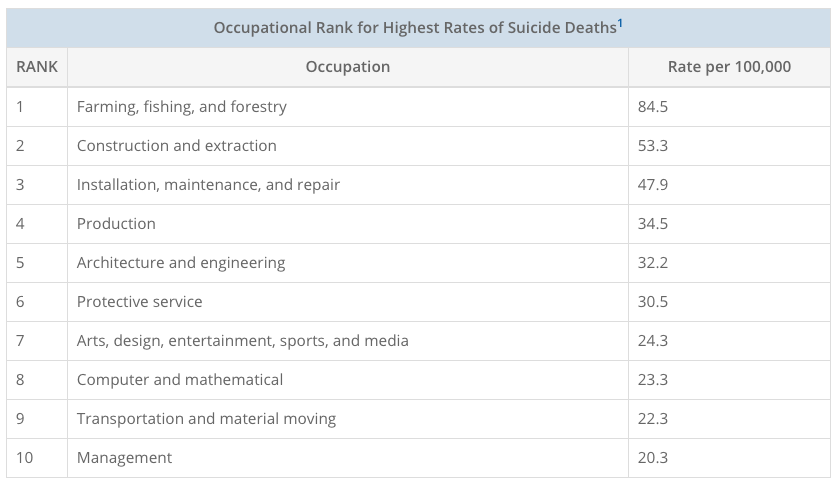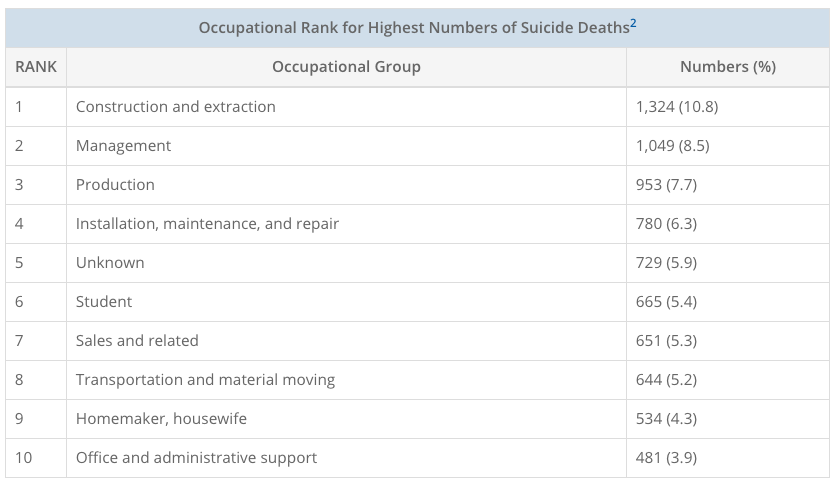Make Suicide Prevention a Health and Safety Priority
On July 1, 2016, the CDC released its report on occupation and suicide for many employers. For the first time, researchers were able to rank industries by deaths by suicide. This milestone report immediately got the attention of risk managers concerned about the health of their workers.
Below is a summary of the CDC’s findings.


For the highest-risk industries, there is often a perfect storm of risk: the demographics of the workforce and the nature of the work itself. Workforces that are male dominated tend to have higher rates of suicide because men die by suicide at nearly four times the rate of women and represent 77.9 percent of all suicides (CDC, 2015). Additionally, industries that have the following qualities also tend to have a higher risk for suicide.
- Access to means of deadly harm (e.g., firearms, pills, high places)
- Culture of fearlessness, recklessness, or stoicism
- Exposed to traumatic events
- Culture of substance abuse
- Fragmented community or isolation
- Humiliation or shame
- Sense of purposelessness
- Entrapment (feeling trapped in a distressing work situation)
The Opioid Influence
Jobs that inflict muscular-skeletal strain sometimes lead to cascading mental health and addiction challenges. Many pain sufferers are legitimately given opioid-based medications to manage their pain, and these medications can quickly lead to addiction. In addition, the emotional aspects of long-term pain often result in hopelessness and isolation.
Temporary Workers
Another risk factor is related to the fact that many workers in high-risk industries are temporary and transitory labor. Because of this fluctuating job situation, workers often have unstable incomes, inconsistent access to health care, and travel demands that take them away from family and friends. Furthermore, they are less likely to find a sense of belonging at work, and experiencing community connectedness is one of the strongest protective factors against suicide.
Conclusion
The good news is that organizations like the National Action Alliance for Suicide Prevention and the Construction Financial Management Association are creating road maps to help companies across all industries integrate psychological safety into existing safety culture.
Because most adults spend more waking hours at work than they do at home, workplaces are critical partners in a community approach to suicide prevention. Employers who value the well-being of their staff realize that it is not good enough to get people home safely from work, they also need to provide support in making sure employees get back to work safely from home. Like most cultural change, a multidimensional, long-term strategy is warranted when integrating mental health services, training, communication strategies, leadership, and crisis response.
For more information or to book Dr. Spencer-Thomas as a speaker/trainer, visit www.SallySpencerThomas.com.
1Wendy LiKamWa McIntosh, Deborah M. Stone, Colby N. Lokey, Aimée-Rika T. Trudeau, Brad Bartholow, “Suicide Rates by Occupational Group—17 States, 2012,” Morbidity and Mortality Weekly Report, Centers for Disease Control and Prevention, July 1, 2016.
2Ibid.
Opinions expressed in Expert Commentary articles are those of the author and are not necessarily held by the author’s employer or IRMI. Expert Commentary articles and other IRMI Online content do not purport to provide legal, accounting, or other professional advice or opinion. If such advice is needed, consult with your attorney, accountant, or other qualified adviser.
Article originally published on International Risk Management Institute (IRMI): https://www.irmi.com/articles/expert-commentary/making-suicide-prevention-a-priority

